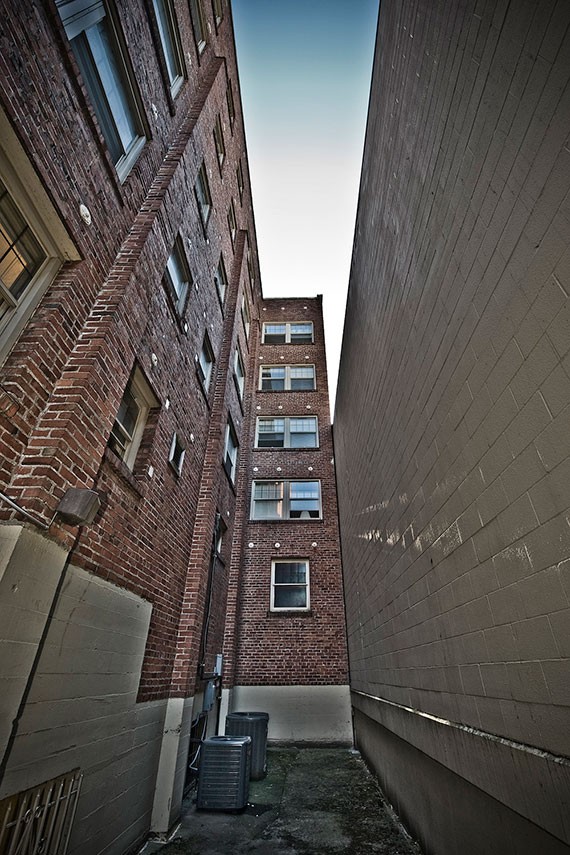In the 1990s, it was cyborgs; in the aughts and teens, zombies. We humans think of ourselves as conscious beings, but our unconscious minds are running the show, say the scientists Christof Koch and Francis Crick—yes, that Crick, co-discoverer of the double helix structure that underpins all life. "An army of unconscious sensory-motor agents" or "zombie agents" drives the whole flow of our behavior. They're the autopilots when we type, walk, brush our teeth. Consciousness is so much slower, so comparatively clumsy. So why and how did it survive evolution? What's it really for?
Scientists aren't the only ones wondering. In a brand-new art installation created for Seattle, Daniel Joseph Martinez uses the gory, automated bodies of zombies to symbolize the relationship between Boeing and NATO. His premise seems to be that the sales of war weapons are the function of a collective unconsciousness. Are they a product of apathy, ignorance, or the natural barbarity of human biology? He doesn't answer that.
In NATO is a subsidiary of BOEING, 28 enclosed church letter boards with locked doors are arranged in a row along the walls of James Harris Gallery. Two small flags that look like a pair of lifted angel wings top each box. The display brings to mind an official hall of flags, but it actually announces the undeath of the 28 NATO nations. Inside the winged boxes, white letters spell zombie-related phrases, gold letters spell out the nation, and a Polaroid is posted. Each Polaroid is a self-portrait of Martinez wearing various zombie masks. Shot at close range, the mutilated features are pushed repulsively close to the lens.
This is Martinez's first appearance in Seattle in 23 years. The Los Angeles–based artist's sensibility was forged in the American culture wars of the early '90s, and his work remains furiously engaged with what's going on in the world. But it's not dualistic, us-versus-them agitprop. Martinez tells horror stories about entanglement.
A quartet of large, cinematic self-portrait photographs welcomes visitors to the gallery. The four images took place after an elaborate makeup session in which Martinez was transformed into a hybrid creature who's both pathetic and menacing. He wears a cracking plaster mask and a papal hat, his exposed arms and belly tattooed with religious phrases in Hebrew, Arabic, and Latin. In two of the pictures, he kneels to pray, curling his grotesque hunchback. He bows down on a mujahideen prayer rug, one made by Afghan women in honor of the Muslim resistance fighters who foiled the Russians in the 1980s. He bends toward the rug's ornate patterns: machine guns, bullets, and bombs. It's now widely known that the US armed the mujahideen in a chess-like move that did not anticipate anything like the ensuing Afghan power vacuum that led to the terrorist attack on the World Trade Center and more, ongoing wars. What's he praying for now?
Martinez's third and final series at James Harris is 12 tightly composed photographs of the Crenshaw neighborhood where he lives—where the Rodney King riots raged. No people appear, but the empty streets are alive with their assortment of religions and cultures, which Martinez contains in a uniform composition: a slice of sky at the top, a slice of street at the bottom, and a stretch of facades in between. Martinez digitally added graffiti of his own, often over actual patches of covered graffiti. He shot during off-hours, when nothing's open and the atmosphere is Seattle-gray. The place just looks tired.
It's no coincidence that Martinez is showing now. Just as the streets are unquiet lately with protests about police violence and the war in Gaza, so noise is leaking into galleries and museums. Mainstream art is still ruled by spectacles, cleverness, and more abstract concepts, but showplaces are dipping their toes (as they cyclically do, but it's been a while) into art that isn't shy about social and political issues. Something is afoot when Nick Cave (the visual artist, not the musician) comes out and says he's bored with the works that have made him famous. "I didn't want to hide behind the Soundsuits anymore," he announced on the recent occasion of his New York gallery show called Made by Whites for Whites. The work is infused with the racist figurines found at antique stores. And no wonder: His first Soundsuit was made of sticks, to protect him as a black man afraid of meeting the same fate as Rodney King, but the later Soundsuits became flashy, fun haute couture. By the time the suits visited Seattle Art Museum in 2011, it was clear that they too easily passed as pageantry. It was time for a course correction.
Other artists in Seattle are showing work they might not have five or ten years ago. At Martyr Sauce in Pioneer Square this month, Tariqa Waters positioned a mannequin whose skin she painted dark brown. Holding his skull in his hands, he wears a hoodie and baggy pants. Rather than a head, there's a video projection atop his body of James Baldwin giving his 1963 "Who Is the Nigger" interview. "White people invented [the term]," Baldwin purrs. "I give you your problem back. You're the nigger, baby. It isn't me."
Complementing Waters's figure, there's a life-size police officer figure wearing full riot gear at the Frye Art Museum. He cowers behind his shield under a storm of empty paper coffee cups raining down around him. Drawing from whatever public records they could get their hands on, the artists, Nicholas and Jerrod Galanin, inscribed each cup with the name of a man of color who has been shot down in recent years, extrajudicially, by police. The cop at first appears to be the victim. But wait: all that armor for paper cups? It's out of proportion for this officer to be as afraid as Nick Cave was in 1992 Los Angeles. The zombie agents are in full effect. ![]()


















